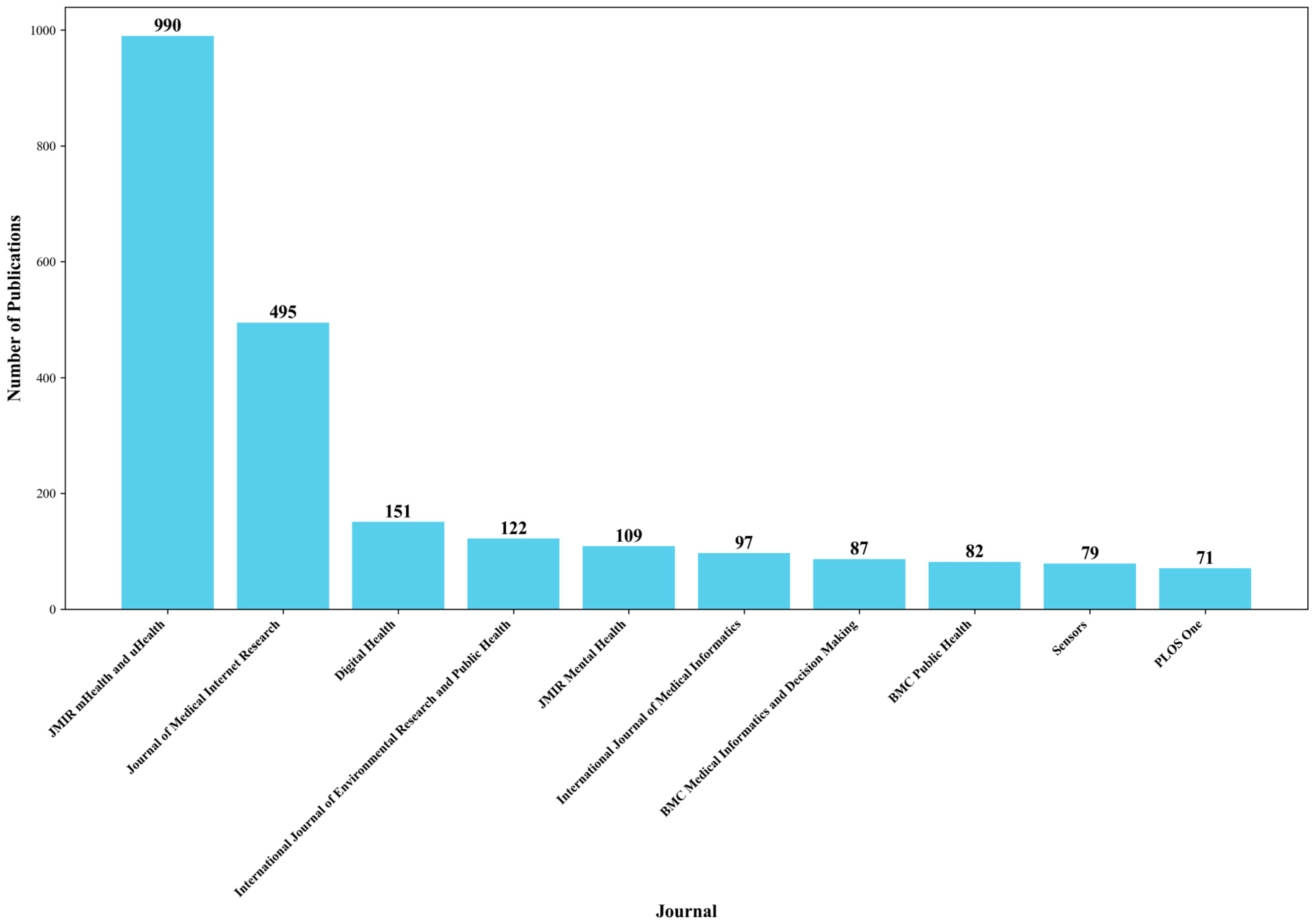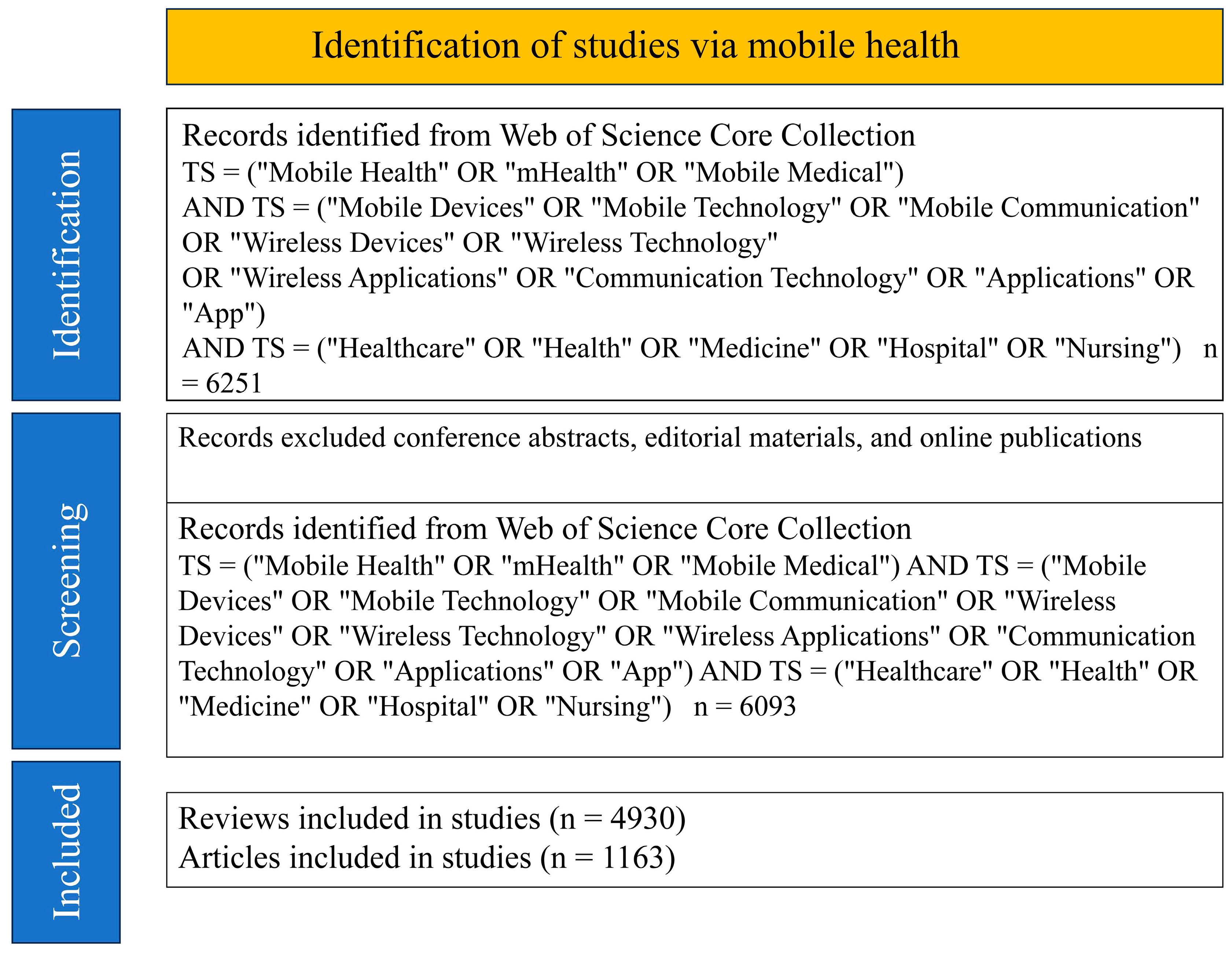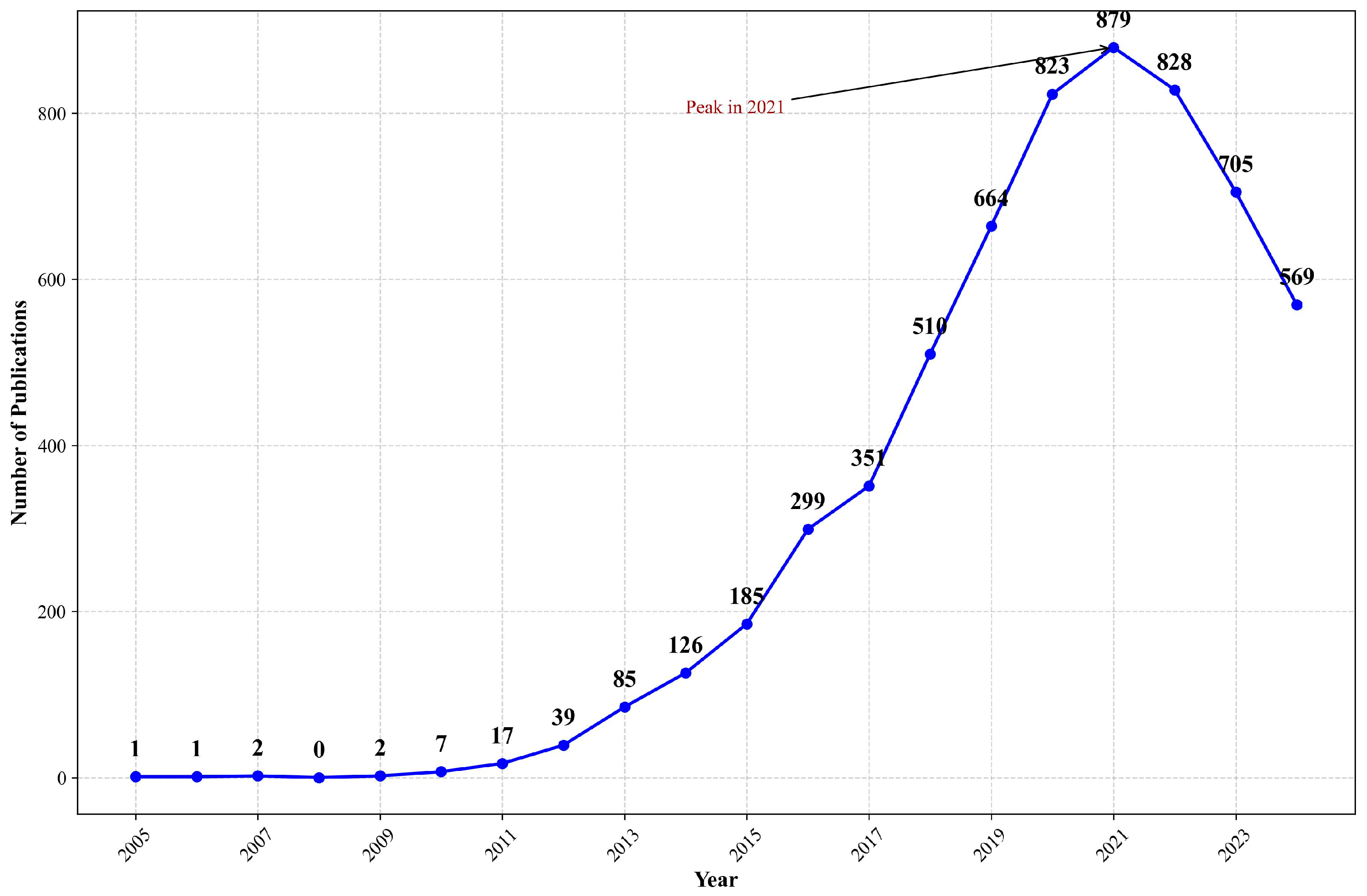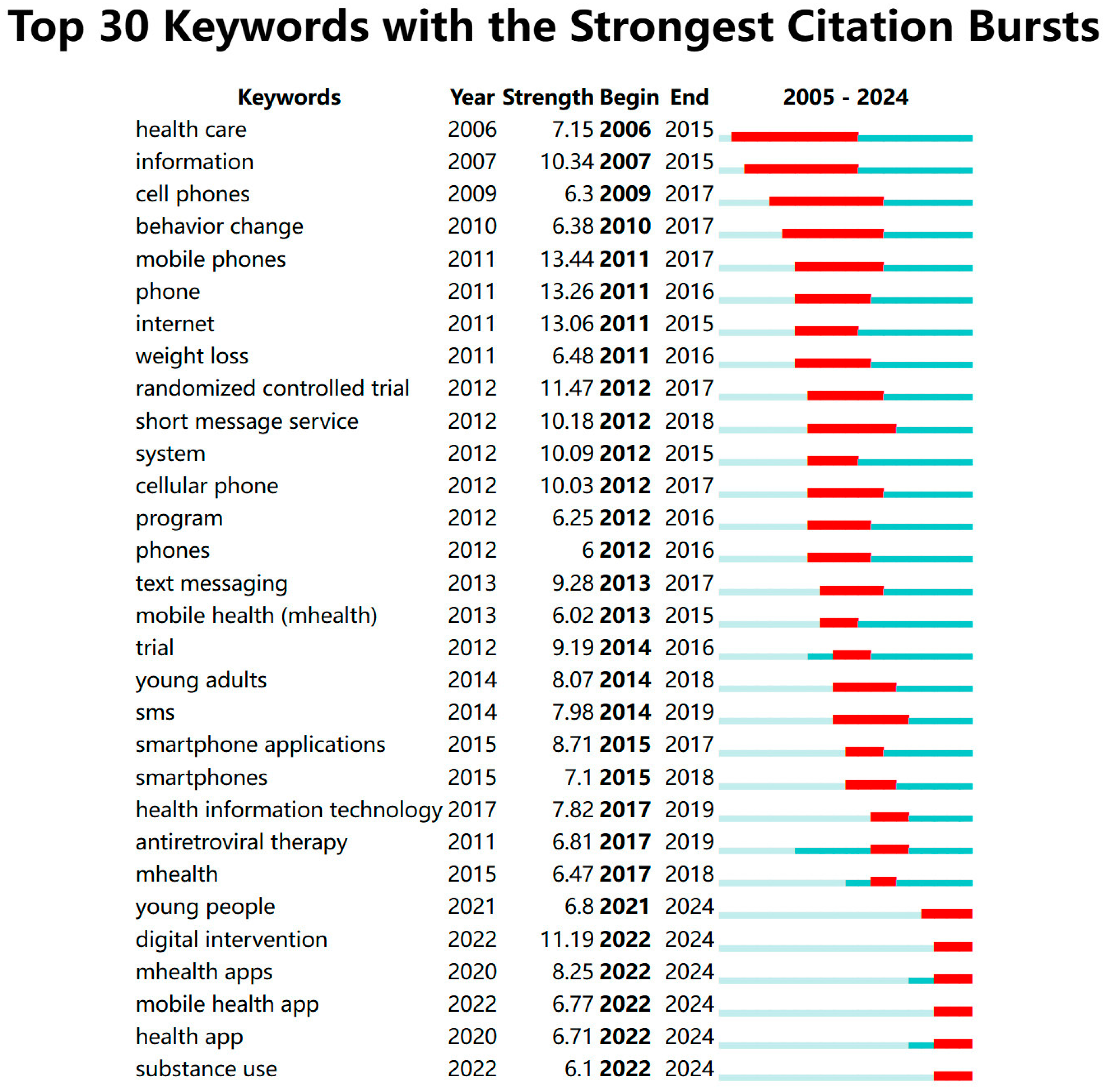Insights into the Technological Evolution and Research Trends of Mobile Health: Bibliometric Analysis
Abstract
1. Introduction
2. Materials and Methods
3. Results
3.1. Analysis of the Trend of Publications
3.2. Distribution of Institutions
3.3. Analysis of Keywords
3.4. Timeline Analysis of Keywords
4. Discussion
4.1. Publishing Trends of mHealth Literature
4.2. International Trends
4.3. An In-Depth Exploration of Research Hotspots
4.4. Potential Concerns Regarding AI Applications in Digital Health
4.5. Frontier Directions in mHealth Research
4.6. Comparison with Prior Work
4.7. Limitations
5. Conclusions
Supplementary Materials
Author Contributions
Funding
Institutional Review Board Statement
Informed Consent Statement
Data Availability Statement
Acknowledgments
Conflicts of Interest
Abbreviations
| mHealth | mobile health |
| AI | Artificial Intelligence |
| WOS | Web of Science database |
| GDPR | General Data Protection Regulation |
| HDAA | Health Insurance Portability and Accountability Act |
Appendix A. Journals and Co-Cited Academic Journals
| Journal | Count | Year | Impact Factor |
|---|---|---|---|
| J MED INTERNET RES | 4025 | 2011 | 5.4 |
| JMIR MHEALTH UHEALTH | 3611 | 2014 | 5.4 |
| PLOS ONE | 2216 | 2013 | 2.9 |
| LANCET | 1436 | 2011 | 168.9 |
| JAMA-J AM MED ASSOC | 1420 | 2011 | 63.1 |
| BMJ-BRIT MED J | 1200 | 2010 | 105.7 |
| AM J PREV MED | 1175 | 2005 | 4.3 |
| TELEMED E-HEALTH | 1175 | 2012 | 2.8 |
| INT J MED INFORM | 1161 | 2006 | 3.7 |
| BMC PUBLIC HEALTH | 1154 | 2012 | 3.5 |


Appendix B. Authors and Co-Cited Authors
| Authors | Record Count | Percent |
|---|---|---|
| Schnall R | 41 | 0.67% |
| Torous J | 41 | 0.67% |
| Bousquet J | 33 | 0.54% |
| Lee S | 26 | 0.43% |
| Kim Y | 26 | 0.43% |
| Pryss R | 24 | 0.39% |
| Lee J | 24 | 0.39% |
| Mohr DC | 24 | 0.39% |
| Kim H | 22 | 0.36% |
| Authors | Record Count |
|---|---|
| Stoyanov SR | 459 |
| Michie S | 423 |
| Eysenbach G | 368 |
| Moher D | 366 |
| Free C | 351 |
| Torous J | 349 |

References
- Alon, N.; Torous, J. Current challenges for evaluating mobile health applications. J. Am. Med. Inform. Assoc. JAMIA 2023, 30, 617–624. [Google Scholar] [CrossRef] [PubMed]
- Istepanian, R.S.H.; Laxminarayan, S.; Pattichis, C.S. M-Health: Emerging Mobile Health Systems; Springer: New York, NY, USA, 2006. [Google Scholar]
- Feng, D.D. Biomedical Information Technology, 1st ed.; Academic Press: Amsterdam, The Netherlands, 2008. [Google Scholar]
- Jat, A.S.; Gronli, T.-M.; Ghinea, G. Navigating Design Science Research in mHealth Applications: A Guide to Best Practices. IEEE Trans. Eng. Manag. 2024, 71, 14472–14484. [Google Scholar] [CrossRef]
- Xu, H.; Huang, S.; Qiu, C.; Liu, S.; Deng, J.; Jiao, B.; Tan, X.; Ai, L.; Xiao, Y.; Belliato, M.; et al. Monitoring and Management of Home-Quarantined Patients With COVID-19 Using a WeChat-Based Telemedicine System: Retrospective Cohort Study. J. Med. Internet Res. 2020, 22, e19514. [Google Scholar] [CrossRef] [PubMed]
- Bickmann, P.; Froböse, I.; Grieben, C. An mHealth Application in German Health Care System: Importance of User Participation in the Development Process. J. Med. Syst. 2024, 48, 20. [Google Scholar] [CrossRef]
- Tarricone, R.; Petracca, F.; Ciani, O.; Cucciniello, M. Distinguishing features in the assessment of mHealth apps. Expert Rev. Pharmacoeconomics Outcomes Res. 2021, 21, 521–526. [Google Scholar] [CrossRef]
- Reddy, L.K.V.; Madithati, P.; Narapureddy, B.R.; Ravula, S.R.; Vaddamanu, S.K.; Alhamoudi, F.H.; Minervini, G.; Chaturvedi, S. Perception about Health Applications (Apps) in Smartphones towards Telemedicine during COVID-19: A Cross-Sectional Study. J. Pers. Med. 2022, 12, 1920. [Google Scholar] [CrossRef]
- Wu, X.; Guo, X.; Zhang, Z. The Efficacy of Mobile Phone Apps for Lifestyle Modification in Diabetes: Systematic Review and Meta-Analysis. JMIR mHealth uHealth 2019, 7, e12297. [Google Scholar] [CrossRef]
- Gentili, A.; Failla, G.; Melnyk, A.; Puleo, V.; Tanna, G.L.D.; Ricciardi, W.; Cascini, F. The cost-effectiveness of digital health interventions: A systematic review of the literature. Front. Public Health 2022, 10, 787135. [Google Scholar] [CrossRef]
- Grand View Research. Share & Trends Analysis Report by Component (Wearables & Connected Wearable Devices, mHealth Apps, Services). Available online: https://www.grandviewresearch.com/industry-analysis/mhealth-market (accessed on 18 November 2024).
- World Health Organization. mHealth: Use of Appropriate Digital Technologies for Public Health: Report by the Director-General 2017. Available online: https://iris.who.int/handle/10665/274134 (accessed on 27 November 2024).
- Aria, M.; Cuccurullo, C. bibliometrix: An R-tool for comprehensive science mapping analysis. J. Informetr. 2017, 11, 959–975. [Google Scholar] [CrossRef]
- Chen, C. CiteSpace II: Detecting and visualizing emerging trends and transient patterns in scientific literature. J. Am. Soc. Inf. Sci. 2006, 57, 359–377. [Google Scholar] [CrossRef]
- Van Eck, N.J.; Waltman, L. Software survey: VOSviewer, a computer program for bibliometric mapping. Scientometrics 2010, 84, 523–538. [Google Scholar] [CrossRef] [PubMed]
- Page, M.J.; McKenzie, J.E.; Bossuyt, P.M.; Boutron, I.; Hoffmann, T.C.; Mulrow, C.D.; Shamseer, L.; Tetzlaff, J.M.; Akl, E.A.; Brennan, S.E.; et al. The PRISMA 2020 statement: An updated guideline for reporting systematic reviews. J. Clin. Epidemiol. 2021, 134, 178–189. [Google Scholar] [CrossRef] [PubMed]
- Cao, J.; Lim, Y.; Sengoku, S.; Guo, X.; Kodama, K. Exploring the Shift in International Trends in Mobile Health Research From 2000 to 2020: Bibliometric Analysis. JMIR mHealth uHealth 2021, 9, e31097. [Google Scholar] [CrossRef]
- Shen, L.; Xiong, B.; Li, W.; Lan, F.; Evans, R.; Zhang, W. Visualizing Collaboration Characteristics and Topic Burst on International Mobile Health Research: Bibliometric Analysis. JMIR mHealth uHealth 2018, 6, e135. [Google Scholar] [CrossRef] [PubMed]
- Stephen, D.A.; Nordin, A.; Nilsson, J.; Persenius, M. Using mHealth applications for self-care—An integrative review on perceptions among adults with type 1 diabetes. BMC Endocr. Disord. 2022, 22, 138. [Google Scholar] [CrossRef]
- Granda-Cameron, C.; Kates, J.; Wen, K.-Y. mHealth Interventions to Improve the Breast Cancer Continuum of Care from Prevention to Survivorship of Hispanic Women: A Scoping Review. J. Racial Ethn. Health Disparities 2024, 11, 1869–1887. [Google Scholar] [CrossRef]
- Dominiak, M.; Gędek, A.; Antosik, A.Z.; Mierzejewski, P. Mobile health for mental health support: A survey of attitudes and concerns among mental health professionals in Poland over the period 2020–2023. Front. Psychiatry 2024, 15, 1303878. [Google Scholar] [CrossRef]
- Daley, B.J.; Ni’Man, M.; Neves, M.R.; Bobby Huda, M.S.; Marsh, W.; Fenton, N.E.; Hitman, G.A.; McLachlan, S. mHealth apps for gestational diabetes mellitus that provide clinical decision support or artificial intelligence: A scoping review. Diabet. Med. 2022, 39, e14735. [Google Scholar] [CrossRef]
- Ding, Y.; Rousseau, R.; Wolfram, D. Measuring Scholarly Impact: Methods and Practice, 1st ed.; Springer International Publishing: Cham, Switzerland, 2014. [Google Scholar]
- Alhammad, N.; Alajlani, M.; Abd-Alrazaq, A.; Epiphaniou, G.; Arvanitis, T. Patients’ Perspectives on the Data Confidentiality, Privacy, and Security of mHealth Apps: Systematic Review. J. Med. Internet Res. 2024, 26, e50715. [Google Scholar] [CrossRef]
- Mordor-Intelligence. Market Report—Industry Analysis, Size & Forecast Overview. Available online: https://www.mordorintelligence.com/industry-reports/it-services-market#:~:text=Detailed%20market%20report%20on%20the%20IT%20services%20market%2C,size%2C%20and%20forecast%20overview%20from%202025%20to%202030 (accessed on 31 December 2024).
- Rock Health. H1 2024 Digital Health Funding: Resilience Leads to Brilliance. Available online: https://rockhealth.com/insights/h1-2024-digital-health-funding-resilience-leads-to-brilliance (accessed on 24 December 2024).
- Jürgens, K.; Raddatz, A.; Tausendfreund, F.; Clemens, T. Market access regulations for mHealth applications in Germany, Austria and Switzerland: A Review. Health Policy Technol. 2024, 13, 100934. [Google Scholar] [CrossRef]
- Liu, P.; Li, X.; Zhang, X.M. Healthcare professionals’ and patients’ assessments of listed mobile health apps in China: A qualitative study. Front. Public Health 2023, 11, 1220160. [Google Scholar] [CrossRef]
- Peng, C.; He, M.; Cutrona, S.L.; Kiefe, C.I.; Liu, F.; Wang, Z. Theme Trends and Knowledge Structure on Mobile Health Apps: Bibliometric Analysis. JMIR mHealth uHealth 2020, 8, e18212. [Google Scholar] [CrossRef] [PubMed]
- Liblub, S.; Pringle, K.; McLaughlin, K.; Cummins, A. Peer support and mobile health for perinatal mental health: A scoping review. Birth 2024, 51, 484–496. [Google Scholar] [CrossRef]
- Mahreen, Z.S.H.; Zainuldin, N.A.; Zhang, M.W. Comprehensive synthesis of mHealth interventions in psychiatry: Insights from systematic, scoping, narrative reviews and content analysis. Singap. Med. J. 2024, 65, 536–543. [Google Scholar] [CrossRef]
- Elkefi, S. Supporting patients’ workload through wearable devices and mobile health applications, a systematic literature review. Ergonomics 2024, 67, 954–970. [Google Scholar] [CrossRef]
- Tian, M.; Zhang, X.; Zhang, J. mHealth as a health system strengthening tool in China. Int. J. Nurs. Sci. 2020, 7, S19–S22. [Google Scholar] [CrossRef]
- Roesler, A.; Butten, K.; Calyx, C.; Holmes-Truscott, E.; Taylor, P. Use and Preferences of Health Apps among Women and Healthcare Professionals Regarding GDM Postpartum Care Related to Diet, Physical Activity, and Weight Management: A Cross-Sectional Survey. Nutrients 2023, 15, 3304. [Google Scholar] [CrossRef]
- Kircher, J.; Swoboda, W.; Holl, F. Examining standardized tools used for the evaluation of mobile health applications for cardiovascular disease. Front. Public Health 2023, 11, 1155433. [Google Scholar] [CrossRef]
- Shrestha, R.; Maviglia, F.; Altice, F.L.; DiDomizio, E.; Khati, A.; Mistler, C.; Azwa, I.; Kamarulzaman, A.; Halim, M.A.A.; Wickersham, J.A. Mobile Health Technology Use and the Acceptability of an mHealth Platform for HIV Prevention Among Men Who Have Sex with Men in Malaysia: Cross-sectional Respondent-Driven Sampling Survey. J. Med. Internet Res. 2022, 24, e36917. [Google Scholar] [CrossRef]
- Demir, E.; Yakutcan, U.; Adeoti, A.O.; Isichei, C.; Adeyemi, S. Evaluating mobile health interventions for HIV patients in Nigeria: Healthcare policy implications from a simulation study. Health Policy Technol. 2024, 13, 100937. [Google Scholar] [CrossRef]
- Baumann, H.; Fiedler, J.; Wunsch, K.; Woll, A.; Wollesen, B. mHealth Interventions to Reduce Physical Inactivity and Sedentary Behavior in Children and Adolescents: Systematic Review and Meta-analysis of Randomized Controlled Trials. JMIR mHealth uHealth 2022, 10, e35920. [Google Scholar] [CrossRef]
- Butler, S.; Sculley, D.; Santos, D.; Fellas, A.; Gironès, X.; Singh-Grewal, D.; Coda, A. Effectiveness of eHealth and mHealth Interventions Supporting Children and Young People Living With Juvenile Idiopathic Arthritis: Systematic Review and Meta-analysis. J. Med. Internet Res. 2022, 24, e30457. [Google Scholar] [CrossRef]
- Bagge-Petersen, C.M.; Langstrup, H.; Larsen, J.E.; Frølich, A. Critical user-configurations in mHealth design: How mHealth-app design practices come to bias design against chronically ill children and young people as mHealth users. Digit. Health 2022, 8, 20552076221109531. [Google Scholar] [CrossRef] [PubMed]
- Vlahu-Gjorgievska, E.; Burazor, A.; Win, K.T.; Trajkovik, V. mHealth Apps Targeting Obesity and Overweight in Young People: App Review and Analysis. JMIR mHealth uHealth 2023, 11, e37716. [Google Scholar] [CrossRef]
- Grosman-Rimon, L.; Wegier, P. With advancement in health technology comes great responsibility—Ethical and safety considerations for using digital health technology: A narrative review. Medicine 2024, 103, e39136. [Google Scholar] [CrossRef] [PubMed]
- Angelucci, A.; Aliverti, A. Telemonitoring systems for respiratory patients: Technological aspects. Pulmonology 2020, 26, 221–232. [Google Scholar] [CrossRef] [PubMed]
- Stachl, C.; Au, Q.; Schoedel, R.; Gosling, S.D.; Harari, G.M.; Buschek, D.; Völkel, S.T.; Schuwerk, T.; Oldemeier, M.; Ullmann, T.; et al. Predicting personality from patterns of behavior collected with smartphones. Proc. Natl. Acad. Sci. USA 2020, 117, 17680–17687. [Google Scholar] [CrossRef]
- Asman, O.; Torous, J.; Tal, A. Responsible Design, Integration, and Use of Generative AI in Mental Health. JMIR Ment. Health 2025, 12, e70439. [Google Scholar] [CrossRef]
- Crawford, A.D.; Geramifar, L.L.; McGlothen-Bell, K.; Salisbury, E. A reproductive justice investigation of utilizing digital interventions among underserved populations with criminal legal system supervision: Policy brief. Nurs. Outlook 2025, 73, 102349. [Google Scholar] [CrossRef]
- Paccoud, I.; Leist, A.K.; Schwaninger, I.; van Kessel, R.; Klucken, J. Socio-ethical challenges and opportunities for advancing diversity, equity, and inclusion in digital medicine. Digit. Health 2024, 10, 20552076241277705. [Google Scholar] [CrossRef]
- Aytekin, A.; Alan, H.; Demirel, H.; Onur, N.; Yalman, A.; Livberber, T.; Yiğit-Açıkgöz, F. Digital Health Technologies in Patient Experience Literature: A Scoping Review and Future Outlook for Sustainable Digital Health Interventions. Sustainability 2025, 17, 456. [Google Scholar] [CrossRef]
- Wen, M.-H.; Chen, P.-Y.; Lin, S.; Lien, C.-W.; Tu, S.-H.; Chueh, C.-Y.; Wu, Y.-F.; Tan Cheng Kian, K.; Hsu, Y.-L.; Bai, D. Enhancing Patient Safety Through an Integrated Internet of Things Patient Care System: Large Quasi-Experimental Study on Fall Prevention. J. Med. Internet Res. 2024, 26, e58380. [Google Scholar] [CrossRef] [PubMed]
- Alòs, F.; Mínguez, D.A.; Cárdenas-Ramos, M.; Cancio-Trujillo, J.M.; Zaldúa, Y.C.; Puig-Ribera, A. Mobile health in primary care. New challenges in the development of solutions to promote physical activity and well-being. Aten. Prim. 2024, 56, 102900. [Google Scholar] [CrossRef]
- Austin, J.A.; Lobo, E.H.; Samadbeik, M.; Engstrom, T.; Philip, R.; Pole, J.D.; Sullivan, C.M. Decades in the Making: The Evolution of Digital Health Research Infrastructure Through Synthetic Data, Common Data Models, and Federated Learning. J. Med. Internet Res. 2024, 26, e58637. [Google Scholar] [CrossRef]
- Sun, L.; Tian, J.; Muhammad, G. FedKC: Personalized Federated Learning With Robustness Against Model Poisoning Attacks in the Metaverse for Consumer Health. IEEE Trans. Consum. Electron. 2024, 70, 5644–5653. [Google Scholar] [CrossRef]
- Xu, S.; Zhong, J.; Wang, L.; He, D.; Zhang, S.; Shao, W. A privacy-preserving and efficient data sharing scheme with trust authentication based on blockchain for mHealth. Connect. Sci. 2023, 35, 2186316. [Google Scholar] [CrossRef]
- Cerda, I.H.; Therond, A.; Moreau, S.; Studer, K.; Donjow, A.R.; Crowther, J.E.; Mazzolenis, M.E.; Lang, M.; Tolba, R.; Gilligan, C.; et al. Telehealth and Virtual Reality Technologies in Chronic Pain Management: A Narrative Review. Curr. Pain Headache Rep. 2024, 28, 83–94. [Google Scholar] [CrossRef]
- Amarelo, A.; Mota, M.; Amarelo, B.; Ferreira, M.C.; Fernandes, C.S. Technological Resources for Physical Rehabilitation in Cancer Patients Undergoing Chemotherapy: A Scoping Review. Cancers 2024, 16, 3949. [Google Scholar] [CrossRef]
- Marques, L.; Costa, B.; Pereira, M.; Silva, A.; Santos, J.; Saldanha, L.; Silva, I.; Magalhães, P.; Schmidt, S.; Vale, N. Advancing Precision Medicine: A Review of Innovative In Silico Approaches for Drug Development, Clinical Pharmacology and Personalized Healthcare. Pharmaceutics 2024, 16, 332. [Google Scholar] [CrossRef]
- Patel, J.; Hung, C.T.; Katapally, T.R. Evaluating predictive artificial intelligence approaches used in mobile health platforms to forecast mental health symptoms among youth: A systematic review. Psychiatry Res. 2025, 343, 116277. [Google Scholar] [CrossRef]











| Institution | Count | Centrality a | Year |
|---|---|---|---|
| University of California System | 248 | 0.09 | 2011 |
| Harvard University | 225 | 0.05 | 2012 |
| University of London | 208 | 0.04 | 2013 |
| Harvard Medical School | 144 | 0.03 | 2012 |
| Johns Hopkins University | 130 | 0.04 | 2013 |
| University of Sydney | 130 | 0.02 | 2014 |
| State University System of Florida | 128 | 0.1 | 2014 |
| University of Toronto | 126 | 0.04 | 2013 |
| Pennsylvania Commonwealth System of Higher Education (PCSHE) | 106 | 0 | 2013 |
Disclaimer/Publisher’s Note: The statements, opinions and data contained in all publications are solely those of the individual author(s) and contributor(s) and not of MDPI and/or the editor(s). MDPI and/or the editor(s) disclaim responsibility for any injury to people or property resulting from any ideas, methods, instructions or products referred to in the content. |
© 2025 by the authors. Licensee MDPI, Basel, Switzerland. This article is an open access article distributed under the terms and conditions of the Creative Commons Attribution (CC BY) license (https://creativecommons.org/licenses/by/4.0/).
Share and Cite
Zhang, R.; Wang, H. Insights into the Technological Evolution and Research Trends of Mobile Health: Bibliometric Analysis. Healthcare 2025, 13, 740. https://doi.org/10.3390/healthcare13070740
Zhang R, Wang H. Insights into the Technological Evolution and Research Trends of Mobile Health: Bibliometric Analysis. Healthcare. 2025; 13(7):740. https://doi.org/10.3390/healthcare13070740
Chicago/Turabian StyleZhang, Ruichen, and Hongyun Wang. 2025. "Insights into the Technological Evolution and Research Trends of Mobile Health: Bibliometric Analysis" Healthcare 13, no. 7: 740. https://doi.org/10.3390/healthcare13070740
APA StyleZhang, R., & Wang, H. (2025). Insights into the Technological Evolution and Research Trends of Mobile Health: Bibliometric Analysis. Healthcare, 13(7), 740. https://doi.org/10.3390/healthcare13070740







